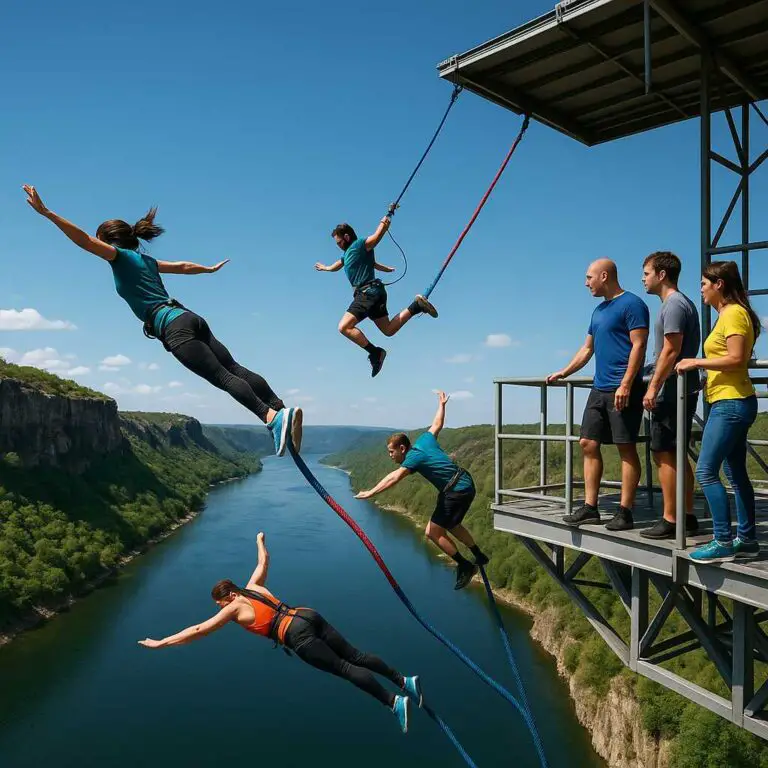🎢 Is Bungee Jumping Safe?
Yes, bungee jumping is generally safe—when performed by licensed operators following rigorous safety protocols. While any extreme sport carries risk, bungee jumping has a very low fatality rate, and injuries are rare when precautions are taken.
According to safety data from 1986 to 2002, only 18 deaths were reported, averaging slightly over one fatality per year. From 2015 to 2018, only five more were recorded. That equates to a risk of about 1 in 500,000 jumps—safer than skydiving or even driving a car.
✅ Bottom line: With the right operator and safety gear, bungee jumping is much safer than it seems.
🔍 Safety Statistics at a Glance
| Metric | Value |
|---|---|
| Fatality Rate | ~1 in 500,000 jumps |
| Avg. Annual Deaths (1986–2002) | 1.1 |
| Deaths from 2015–2018 | 5 total |
| Compared to skydiving | ~1 in 100,000 risk |
Source: Outdoor Troop, OutdooRight
🏢 Choosing a Safe Bungee Jump Operator
✅ 1. Research & Reviews
Read customer feedback on Google, TripAdvisor, or Yelp. Look for:
-
Long track record with zero incidents
-
Trained and certified staff
-
Well-maintained facilities
✅ 2. Certification & Standards
Your chosen operator should meet these criteria:
-
Member of national or international bungee organizations
-
Uses ISO-certified equipment
-
Performs regular safety inspections
🧰 Equipment Safety Essentials
🪢 Bungee Cord
-
Made from high-quality rubber strands encased in fabric
-
Must be inspected frequently for elasticity degradation
-
Designed to handle forces 2–4x the jumper’s body weight
🛒 Bungee Cord Replacement Kit (Amazon) – For home training demos or stunt rigs
🧗♀️ Harnesses & Carabiners
-
Must fit snugly around your waist and legs
-
Made from climbing-grade nylon and metal
-
Equipped with backup carabiners for redundancy
🛒 Adjustable Full Body Bungee Harness (Amazon)
🛒 Climbing Locking Carabiners Set (Amazon)
🧑⚕️ Pre-Jump Safety Measures
🧬 1. Health Checks
Disclose these conditions:
-
Heart disease or high blood pressure
-
Pregnancy
-
Spinal or neurological issues
-
Recent surgeries
⚠️ Operators may refuse a jump to protect your health and liability.
⚖️ 2. Weight & Age Limits
Most operators follow this guideline:
| Requirement | Typical Value |
|---|---|
| Minimum weight | ~40 kg (88 lbs) |
| Maximum weight | 110–120 kg (242–265 lbs) |
| Minimum age | 12–14 years old |
| Parental consent needed | Under 18 |
🎧 Following Pre-Jump Instructions
Your safety briefing will include:
-
How to maintain a relaxed body posture
-
When to lift your legs or hold your arms
-
What to expect during recoil and landing
🛒 Noise-Canceling Earbuds for Focus (Amazon) – Great if you’re jump training near loud areas
🔋 Bonus Gear for Enthusiasts & Trainers
| Gear | Why It Helps |
|---|---|
| GoPro Hero12 Black | Capture your jump safely |
| Shock-Absorbing Helmet | Useful for training jumps or sport demos |
| Altitude Monitor Watch | Track elevation and pulse rate |
🧠 Pro Tips for a Safer Bungee Jump
-
Ask questions—Don’t hesitate to confirm gear inspections or certifications.
-
Avoid alcohol or heavy meals before your jump.
-
Stretch beforehand to reduce post-jump muscle soreness.
-
Stay calm—trust the gear and your guides.
🧭 Conclusion
Bungee jumping offers one of the most thrilling adrenaline rushes imaginable. And when done correctly, it’s remarkably safe. With rigorous operator standards, certified equipment, and a few basic precautions, you can confidently take the plunge.
🎯 Whether you’re preparing for your first jump or reviewing safety tips before your next leap, remember: thrill is temporary—safety is permanent.








